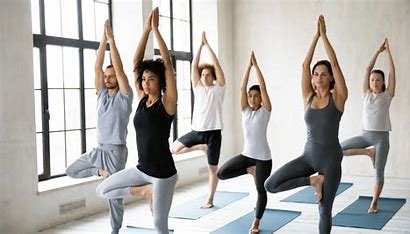Yoga is an excellent practice for improving mobility, as it focuses on enhancing flexibility, strength, balance, and body awareness. Through regular practice, yoga helps to stretch and lengthen muscles, open up joints, and improve overall movement patterns. Here’s how yoga can improve mobility:

1. Increases Flexibility
Many yoga poses involve deep stretches that lengthen muscles and promote joint flexibility. Flexibility, especially in areas like the hips, hamstrings, back, and shoulders, is essential for mobility. By regularly practicing yoga, you can gradually improve your range of motion and move more freely.
2. Improves Joint Health
Yoga poses help to move joints through their full range of motion, which can improve joint lubrication and prevent stiffness. For example, poses like Cat-Cow (to mobilize the spine) or Downward Dog (to stretch the shoulders, hamstrings, and calves) encourage healthy movement and joint health.
3. Enhances Balance and Coordination
Many yoga poses challenge balance and require stabilizing muscles to engage. As you improve your balance, you’ll also develop better coordination between your body parts. This enhanced coordination helps with smoother, more controlled movements, contributing to better overall mobility.
4. Strengthens Muscles
Yoga is not just about flexibility—it also builds strength, particularly in stabilizing muscles that support joint movement. Poses like Plank or Warrior strengthen core and leg muscles, which improves posture and supports more efficient and controlled movement.
5. Relieves Muscle Tension
Regular yoga practice helps release tightness in muscles, especially in areas where tension builds up due to stress, poor posture, or inactivity. Poses such as Child’s Pose or Forward Fold can target tight areas like the lower back, shoulders, and hips, reducing stiffness and enhancing mobility.
6. Promotes Body Awareness
Yoga encourages mindfulness, which helps you tune into your body’s movements and sensations. This increased awareness allows you to move more efficiently and avoid unnecessary strain or discomfort, contributing to improved mobility over time.
7. Opens Up the Hips and Shoulders
Tight hips and shoulders are common mobility limitations. Many yoga poses—such as Pigeon Pose for the hips and Shoulder Bridge for the shoulders—target these areas, opening up the hips and increasing the range of motion in the shoulders, which can improve overall functional movement.
8. Supports the Spine and Posture
A healthy spine is crucial for maintaining mobility. Yoga poses like Cobra, Cat-Cow, and Seated Forward Fold promote spinal flexibility, reduce stiffness, and encourage a neutral spine. Good posture helps prevent injury and allows for freer, more natural movement throughout the body.
9. Relieves Stress and Reduces Muscle Tightness
Yoga is known for its calming effects, and stress relief can directly impact muscle tightness. Reduced stress levels help the body relax, which can alleviate muscle tension and increase your range of motion.
10. Aids in Recovery from Injury
Yoga can be a great recovery tool, helping to gently stretch and strengthen muscles while maintaining mobility. By using gentle movements and focusing on alignment, yoga can be beneficial for individuals recovering from injury or those dealing with chronic pain or stiffness.
Key Yoga Poses for Improving Mobility:
Here are a few yoga poses that are particularly helpful for enhancing mobility:
- Downward-Facing Dog: Stretches the hamstrings, calves, and shoulders while strengthening the arms and legs.
- Pigeon Pose: Opens up the hips and relieves tightness in the glutes and lower back.
- Warrior II: Builds strength in the legs while improving hip flexibility and balance.
- Child’s Pose: Relieves tension in the back, hips, and shoulders, promoting relaxation and gentle stretching.
- Cat-Cow Stretch: Increases spinal mobility and flexibility, improving movement in the lower back and shoulders.
- Crescent Lunge: Stretches the hip flexors, quadriceps, and hamstrings, improving lower body mobility.
- Seated Forward Fold: Targets the hamstrings and lower back, helping to release tension and increase flexibility.
Best Practices for Yoga and Mobility:
- Start Slowly: If you’re new to yoga, start with basic poses and gradually increase the complexity of your practice.
- Focus on Breathing: Deep breathing encourages relaxation and helps you move deeper into stretches.
- Consistency is Key: Regular practice, even if it’s only 10–20 minutes a few times a week, will yield the best results.
- Listen to Your Body: Always honor your body’s limits. Don’t push yourself too far in any pose—over time, mobility will improve naturally.
